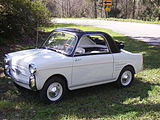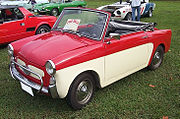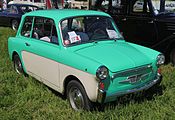Autobianchi_Bianchina
Autobianchi Bianchina
Motor vehicle
The Autobianchi Bianchina is a minicar produced by the Italian automaker Autobianchi, based on the Fiat 500's chassis and mechanicals. It was available in various configurations: Berlina (saloon), Cabriolet (roadster), Trasformabile (fixed profile convertible), Panoramica (station wagon), and Furgoncino (van). The car was presented to the public on 16 September 1957 at the Museum of Science and Technology in Milan.
Initially, the car was equipped with the smallest Fiat engine, air-cooled 479 cc, producing 15 PS (11 kW). In 1959, the engine power was increased to 16.5 PS (12.1 kW) and in 1960, the cabriolet version was launched.
In the same year, the Trasformabile, whose engine cylinder capacity was increased to 499 cc and 17.5 PS (12.9 kW), was made available in a Special version with bicolour paint and an engine enhanced to 21 PS (15.4 kW). This body style featured a fixed B-pillar and partial roof, like the rest of the opening was covered with a foldable fabric hood, while the Cabriolet version had no B-pillar. The Trasformabile was the only version to feature suicide doors, and in 1962, it was replaced by a four-seat saloon. The engine and chassis were the same in both.
In 1965, a minor facelift was made and in the Berlina, the regular engine gained a half horsepower.
In France, the various Bianchina models were sold under different names: the Berlina became the Lutèce, the Familiare the Texane, and the Cabriolet was marketed as the Eden Roc.[1]





